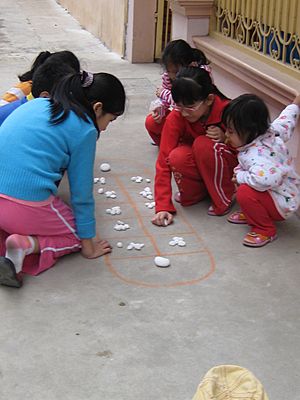Ô ăn quan facts for kids
Ô ăn quan (pronounced "Oh Ahn Kwahn") is a super fun and traditional Vietnamese board game for kids! Its name means "Mandarin Square Capturing." This game is great for helping you think and plan your moves. It also helps you get better at counting!
Contents
How to Play Ô ăn quan
The Game Board
The game board is usually drawn on the ground. It looks like a big rectangle. This rectangle has ten smaller squares inside it (like 5 squares in a row, with two rows). These ten squares are called "rice field squares." At each end of the big rectangle, there's a half-circle shape. These are called "Mandarin squares."
What You Play With
You can use small stones, fruit seeds, or other tiny objects as game pieces.
Players
Two players or two teams play this game. Each player or team sits on one side of the board. They control the squares on their side.
Setting Up the Game
To start, each player puts one large stone (or ten small stones) into their "Mandarin square." This big stone is called the "Mandarin piece." Then, put five small stones (called "citizen pieces") into each of the ten "rice field squares."
The Goal of the Game
The game ends when all the pieces are captured. Your goal is to capture more pieces than the other player! A "Mandarin piece" is worth ten (or sometimes five) "citizen pieces."
If both "Mandarin pieces" are captured, any "citizen pieces" left on the board belong to the player whose side they are on. There's a saying in Vietnam for this: "Mandarin is gone, citizen dismisses, take back the army, retreat." The player with the most pieces at the end wins!
How to Start
Players usually play rock paper scissors to decide who goes first.
Scattering Pieces
The first player chooses any "rice field square" on their side. They pick up all the pieces from that square. Then, they start placing one piece in each square, moving in either direction (clockwise or counter-clockwise).
When they run out of pieces to drop, they pick up all the pieces from the *next* square and keep distributing them. They keep doing this until they drop the last piece into an empty square.
If a player's side of the board becomes empty, they need to put five pieces back onto their side. They use pieces they have already won. They place one piece in each of their five "rice field squares." If they don't have enough pieces, they might need to borrow from the other player. They return these borrowed pieces when counting points at the end.
Capturing Pieces
You capture pieces when you drop your last piece into a square, and the *very next* square after it is empty. If this happens, you get to take all the pieces from the square *after* the empty one! This square is sometimes called a "rich square" because it has many pieces.
If the square after your last piece is an empty "Mandarin square," or if the next two squares are empty, your turn ends. Then it's the other player's turn.
Sometimes, in different versions of the game, the "Mandarin square" might have small "citizen pieces" that cannot be captured. These are called quan non (young Mandarin).
A Game Song
Children sometimes sing a special song while playing this game. It's called a đồng dao (children's song):
- Hàng trầu hàng cau The betel stall, the areca nut stall
- Là hàng con gái Be stalls of girls
- Hàng bánh hàng trái The cake stall, the fruit stall
- Là hàng bà già Be stalls of old women
- Hàng hương hàng hoa The incense stall, the flower stall
- Là hàng cúng Phật. Be stalls for offering the Buddha.
Ô ăn quan in History
A long time ago, a smart person named Mạc Hiển Tích is said to have thought about "negative numbers" because of the rules of this game!
A Common Saying
There's a Vietnamese saying that comes from this game: "Một đập ăn quan." This means "one move captures Mandarin piece." It's used to describe when someone gets a big, successful result from a simple action.
Game Variations
There are even versions of Ô ăn quan for three or four players!
Images for kids




